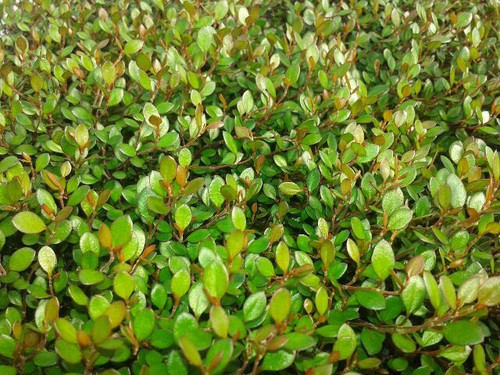Product Description
Muehlenbeckia axillaris
Common Name: Creeping Wire Vine
Zones 6 to 9.
Full sun to part shade.
Plants reach 2 to 4 inches tall and 24 inches wide.
evergreen creeping groundcover.
Growth rate: Vigorous.
Small, rounded leaves with glossy green finish forms a spreading mat of wiry stems; in late spring to early summer green flower bloom and subsequently form white berries. Fall and winter foliage color is bronze, green.
Muehlenbeckia axillaris, also known as Creeping Wire Vine or Matted Lignum, is a versatile and vigorous groundcover plant native to New Zealand and Australia. It is admired for its unique wiry texture, adaptability, and ability to create a dense, low-growing mat.
- Wiry stems: The plant is characterized by its thin, wiry, reddish-brown stems that intertwine to form a dense mat.
- Small leaves: It has small, rounded, glossy green leaves that are less than 1 cm in diameter.
- Spreading habit: Muehlenbeckia axillaris spreads quickly, reaching up to 1 meter in diameter, making it an excellent groundcover for suppressing weeds.
- Inconspicuous flowers: It produces small, yellowish-white flowers in spring that are often hidden by the foliage.
- Attractive fruits: The flowers are followed by small, black, shiny fruits that add visual interest.
Uses in the Garden:
- Groundcover: Its dense growth habit makes it ideal for covering large areas and preventing weed growth.
- Rock gardens: The wiry texture adds contrast and interest to rock gardens.
- Erosion control: It can be used on slopes and banks to help stabilize the soil and prevent erosion.
- Containers and hanging baskets: The trailing stems can spill over the edges of containers and hanging baskets, creating a beautiful cascading effect.
- Bonsai: Due to its wiry growth habit and small leaves, it is sometimes used in bonsai.
Growing Conditions:
- Sunlight: It thrives in full sun to part shade.
- Soil: Prefers well-drained soil but tolerates a variety of soil types.
- Watering: It is drought-tolerant once established but benefits from regular watering during hot, dry periods.
- Hardiness: It is hardy in USDA zones 6-10.
Benefits:
- Low maintenance: Once established, it requires minimal care.
- Drought-tolerant: Can withstand periods of dryness.
- Quick-growing: Fills in quickly to cover bare ground.
- Versatile: Can be used in a variety of garden settings.
If you are looking for a unique and adaptable groundcover that adds texture and interest to your garden, Muehlenbeckia axillaris is an excellent choice.
Excellent for large areas and stabilizing or erosion control on slopes, containers, drought tolerant, ground cover, mass plantings, and tolerates fairly high foot traffic. Mow foliage at the highest possible cutting height in late winter before new growth. Deer resistant.
Ten (10) plants in 4.5-inch containers per flat (or tray).
Other Details
The most important part of the plant is its root system. Healthy roots are the foundation of a healthy, vibrant plant. The type of plug container used is based on the specific needs of the plants. Perennials offered as bare root traditionally perform better when planted as bare root.Planted in a specialized mix, potted plants have well established root systems. Top growth stage will vary depending on the current life cycle and time of year when shipped. In Winter and early Spring dormant plants may be shipped. Dormant plants may be planted right away, even before the last frost date.
Most bare root varieties are field grown for at least one season, though Hemerocallis and Hosta are grown for two seasons. The bulk of the soil is removed during the harvesting process and the tops of most varieties are trimmed back to the crown. They are graded, packed in shredded aspen or sphagnum moss and stored in freezers until ready to be shipped.
See our Container Sizes and Bare Root Perennials pages for more information.
Plant information and care is provided in the Overview section, Plant Genus Page and general information is provided in the Planting Care & Guides. Additional questions can be asked on each Plant page.
Plant Spacing: Using the maximum mature spread or width of a plant to guide spacing, ensures space to grow to full size. To fill an area sooner, plant them closer together. Just remember, future thinning or transplanting may be needed.
Water: Keep a close eye on newly planted perennials, especially throughout the first growing year. Most early plant loss is due to too much or too little water!





